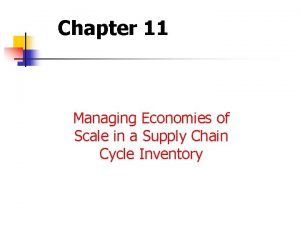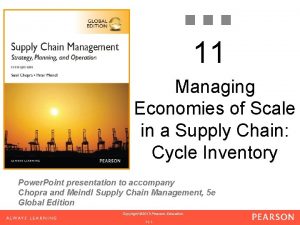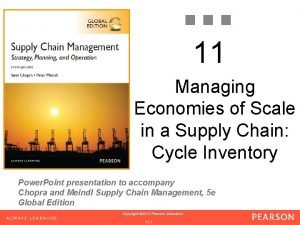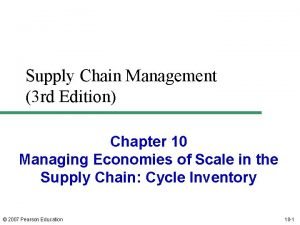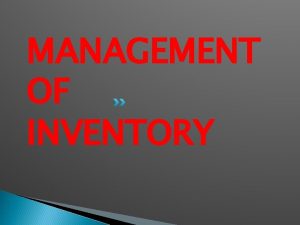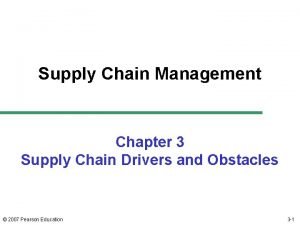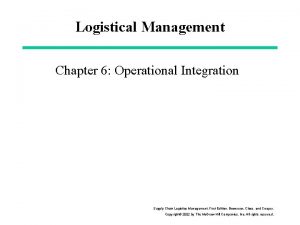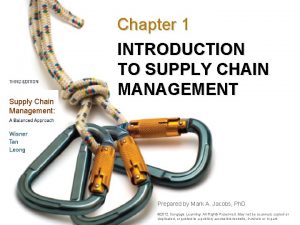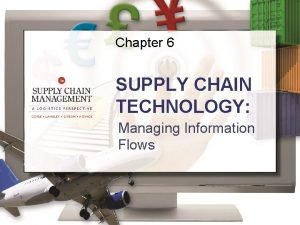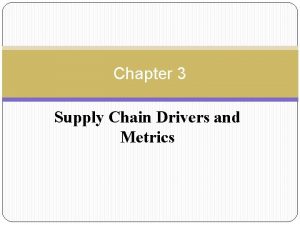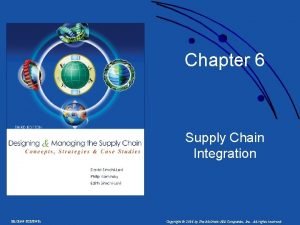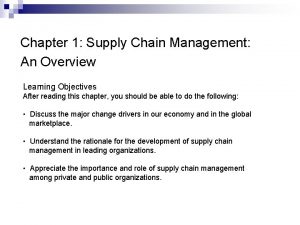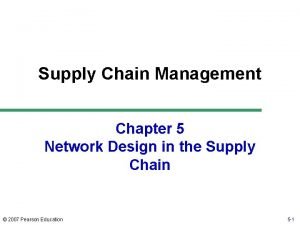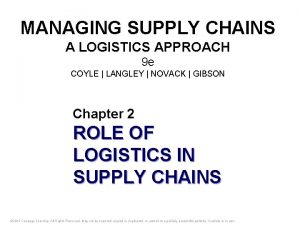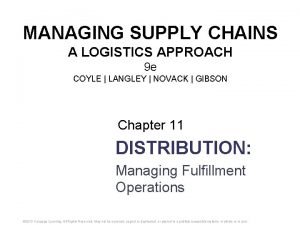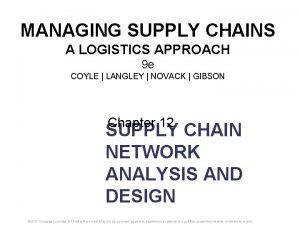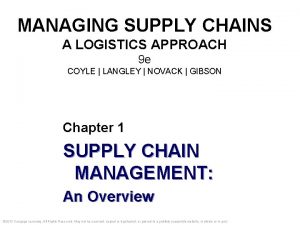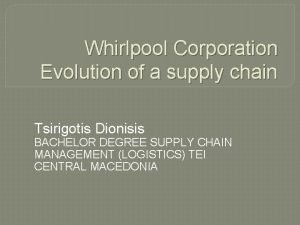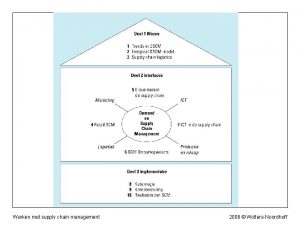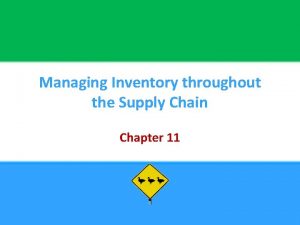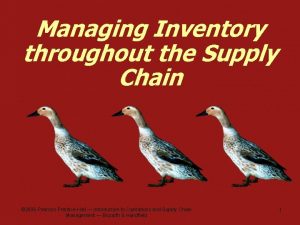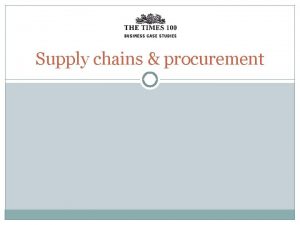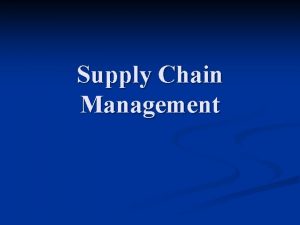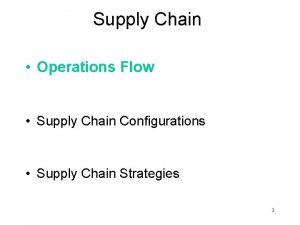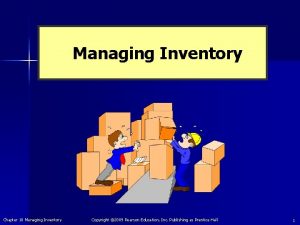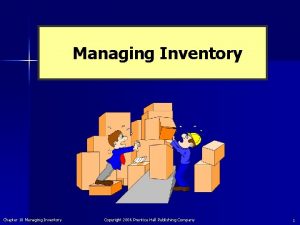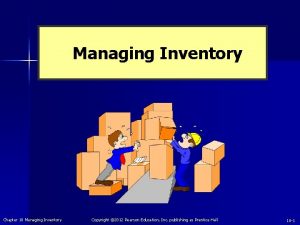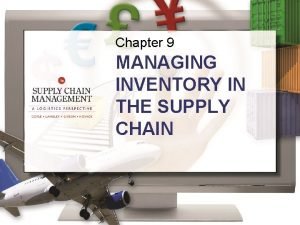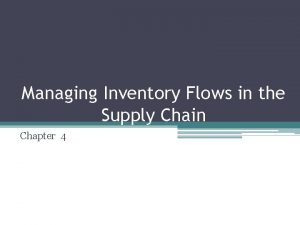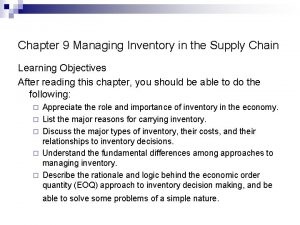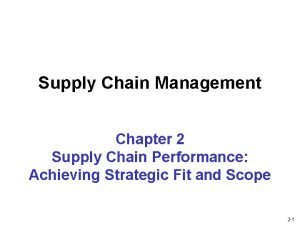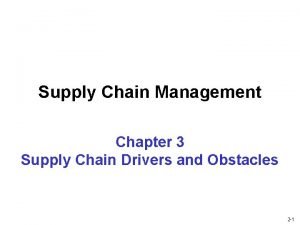Chapter 11 Managing Inventory throughout the Supply Chain


























- Slides: 26

Chapter 11 Managing Inventory throughout the Supply Chain

Chapter Objectives 11 Be able to: §Describe the various roles of inventory, including the different types of inventory and inventory drivers, and distinguish between independent demand inventory. §Calculate the restocking level for a periodic review system. §Calculate the economic order quantity (EOQ) and reorder point (ROP) for a continuous review system, and determine the best order quantity when volume discounts are available. §Calculate the target service level and target stocking point for a single-period inventory system. §Describe how inventory decisions affect other areas of the supply chain. In particular, describe the bullwhip effect, inventory positioning issues, and the impacts of transportation, packaging, and material handling considerations. Copyright © 2016 Pearson Education, Inc. 2 11 -2

Inventory Management 11 § Inventory – Those stocks or items used to support production (raw materials and work-in-process items), supporting activities (maintenance, repair, and operating supplies) and customer service (finished goods and spare parts). © 2013 APICS Dictionary Copyright © 2016 Pearson Education, Inc. 3 11 -3

Inventory Types 11 § Cycle stock § Safety stock § Anticipation inventory § Hedge inventory § Transportation inventory § Smoothing inventory Copyright © 2016 Pearson Education, Inc. 4 11 -4

Types of Inventory 11 § Cycle stock – Components or products that are received in bulk by a downstream partner, gradually used up, and then replenished again in bulk by an upstream partner. § Safety stock – Extra inventory that a company holds to protect itself against uncertainties in either demand or replenishment time. Copyright © 2016 Pearson Education, Inc. 5 11 -5

Types of Inventory 11 § Anticipation inventory – Inventory that is held in anticipation of customer demand. § Hedge inventory – A form of inventory buildup to buffer against some event that may not happen. © 2013 APICS Dictionary Copyright © 2016 Pearson Education, Inc. 6 11 -6

Types of Inventory 11 § Transportation inventory – Inventory that is moving from one link in the supply chain to another. § Smoothing inventory – Inventory that is used to smooth out differences between upstream production levels and downstream demand. Copyright © 2016 Pearson Education, Inc. 7 11 -7

Inventory Drivers 11 § Inventory drivers – Business conditions that force companies to hold inventory. Table 11. 2 Copyright © 2016 Pearson Education, Inc. 8 11 -8

Inventory Drivers 11 § Supply Uncertainty – The risk of interruptions in the flow of components from upstream suppliers. § Demand Uncertainty – The risk of significant and unpredictable fluctuations in downstream demand. Copyright © 2016 Pearson Education, Inc. 9 11 -9

Independent vs. Dependent Demand Inventory 11 § Independent demand inventory – Inventory items whose demand levels are beyond a company’s complete control. § Dependent demand inventory – Inventory items whose demand levels are tied directly to a company’s planned production of another item. Copyright © 2016 Pearson Education, Inc. 10 11 -10

Independent vs. Dependent Demand Inventory 11 § Example: § Independent demand: § Kitchen table – Need 500 tables five weeks from now § Dependent demand: § Kitchen table legs – Need 4 per table or 2, 000 legs § Calculation of dependent demand (Chapter 12) Copyright © 2016 Pearson Education, Inc. 11 11 -11

Periodic Review System 11 § Periodic Review System – An inventory system that is used to manage independent demand inventory where the inventory level for an item is checked at regular intervals and restocked to some predetermined level. Copyright © 2016 Pearson Education, Inc. 12 11 -12

Periodic Review System 11 Order quantity (Q) = The amount required to bring the inventory level back up to R. Q=R-I where Q = order quantity R = restocking level I = inventory level at the time of review. Figure 11. 6 Copyright © 2016 Pearson Education, Inc. 13 11 -13

Periodic Review System 11 Restocking Level (R) Copyright © 2016 Pearson Education, Inc. 14 11 -14

Periodic Review System 11 § Service Level – A term used to indicate the amount of demand to be met under conditions of demand supply uncertainty. § Assumes that the demand during the reorder period and the order lead time is normally distributed. Copyright © 2016 Pearson Education, Inc. 15 11 -15

Continuous Review System 11 § Continuous Review System – An inventory system used to manage independent demand inventory where the inventory level for an item is constantly monitored and when the reorder point is reached, an order is released. Copyright © 2016 Pearson Education, Inc. 16 11 -16

Continuous Review System 11 § Key features: § Inventory levels are monitored constantly, and a replenishment order is issued only when a preestablished reorder point has been reached. § The size of a replenishment order is typically based on the trade-off between holding costs and ordering costs. § The reorder point is based on both demand supply considerations, as well as on how much safety stock managers want to hold. Copyright © 2016 Pearson Education, Inc. 17 11 -17

Continuous Review System 11 § Assumptions: § The inventory item we are interested in has a constant demand period (d). That is, there is no variability in demand from one period to the next. Demand for the year is D. § L is the lead time, or number of periods that must pass before a replenishment order arrives. L is also constant. § H is the cost of holding a single unit in inventory for a year. It includes the cost of the space needed to store the unit, the cost of potential obsolescence, and the opportunity cost of tying up the organization’s funds in inventory. H is known and fixed. § S is the cost of placing an order, regardless of the order quantity. S is also known and fixed. § P, the price of each unit, is fixed. Copyright © 2016 Pearson Education, Inc. 18 11 -18

Continuous Review System 11 § The decision of how much safety stock to hold depends on five factors: § The variability of demand § The variability of lead time § The average length of lead time § The desired service level § The average demand Copyright © 2016 Pearson Education, Inc. 19 11 -19

Quantity Discounts 11 § Quantity Discounts – Price reductions for ordering larger quantities. Copyright © 2016 Pearson Education, Inc. 20 11 -20

Quantity Discounts 11 § Two-step process: 1. Calculate the EOQ. If the EOQ represents a quantity that can be purchased for the lowest price, stop – we have found the lowest cost order quantity. Otherwise, go to Step 2. 2. Compare total holding, ordering, and item costs at the EOQ quantity with total costs at each price break above the EOQ. There is no reason to look at quantities below the EOQ, as these would result in higher holding and ordering costs, as well as higher item costs. Copyright © 2016 Pearson Education, Inc. 21 11 -21

Single-Period Inventory Systems 11 § When excess inventory cannot be held in the future, firms must weigh the cost of being short against the cost of holding excess unit. § The following costs are calculated: Copyright © 2016 Pearson Education, Inc. 22 11 -22

Single-Period Inventory Systems 11 § Single-period inventory system – A system used when demand occurs in only a single point in time. § Two-step process: § Determine a target service level (SLT) that strikes the best balance between shortage costs and excess costs. § Use the target service level to determine the target stocking point (TS) for the item. Copyright © 2016 Pearson Education, Inc. 23 11 -23

Single-Period Inventory Systems 11 § Target service level – The service level at which the expected cost of a shortage equals the expected cost of having excess units. § Target stocking point – The stocking point at which the expected cost of a shortage equals the expected cost of having excess units. Copyright © 2016 Pearson Education, Inc. 24 11 -24

Inventory in the Supply Chain 11 § Bullwhip Effect § An extreme change in the supply position upstream in a supply chain generated by a small change in demand downstream in the supply chain. © 2013 APICS Dictionary Copyright © 2016 Pearson Education, Inc. 25 11 -25

Inventory in the Supply Chain 11 § Inventory Positioning – Deciding where in the supply chain to hold inventory. § The cost and value of inventory increase as materials move down the supply chain. § The flexibility of inventory decreases as materials move down the supply chain. § Inventory Pooling – Holding safety stock in a single location instead of multiple locations. § Transportation, Packaging and Material Handling Considerations Copyright © 2016 Pearson Education, Inc. 26 11 -26
 Managing uncertainty in supply chain safety inventory
Managing uncertainty in supply chain safety inventory Managing economies of scale in a supply chain
Managing economies of scale in a supply chain Economies of scale supply chain
Economies of scale supply chain Managing economies of scale in a supply chain
Managing economies of scale in a supply chain Marginal unit quantity discount
Marginal unit quantity discount Matching supply with demand
Matching supply with demand Value chain and supply chain difference
Value chain and supply chain difference Grazing food chain diagram
Grazing food chain diagram Chapter 5 section 1 supply and the law of supply
Chapter 5 section 1 supply and the law of supply Meaning of inventry
Meaning of inventry Chapter 3 supply chain drivers and metrics
Chapter 3 supply chain drivers and metrics Operational integration in logistics
Operational integration in logistics Chapter 1 supply chain management
Chapter 1 supply chain management Chapter 6 supply chain management
Chapter 6 supply chain management Supply chain drivers definition
Supply chain drivers definition Dell supply chain case study
Dell supply chain case study Chapter 1 supply chain management
Chapter 1 supply chain management Network design in the supply chain chapter 5
Network design in the supply chain chapter 5 Managing supply chains a logistics approach
Managing supply chains a logistics approach Managing supply chains: a logistics approach
Managing supply chains: a logistics approach Managing supply chains a logistics approach
Managing supply chains a logistics approach Managing supply chains a logistics approach
Managing supply chains a logistics approach Ratio ng elastisidad
Ratio ng elastisidad Whirlpool corporation evolution of a supply chain
Whirlpool corporation evolution of a supply chain Werken met supply chain management
Werken met supply chain management Vfp viewpoint
Vfp viewpoint Contemporary management practices
Contemporary management practices

